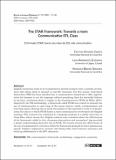| dc.contributor.author | Olivares, Cinthya | |
| dc.contributor.author | Barrantes, Lena | |
| dc.contributor.author | Brenes Sánchez, Verónica | |
| dc.date.accessioned | 2020-09-24T19:47:46Z | |
| dc.date.available | 2020-09-24T19:47:46Z | |
| dc.date.issued | 2020 | |
| dc.identifier.issn | 1659-1933 | |
| dc.identifier.uri | http://hdl.handle.net/11056/18244 | |
| dc.identifier.uri | https://revistas.ucr.ac.cr/index.php/rlm/article/view/42499 | |
| dc.description.abstract | English instruction needs to be transformed to provide learners with a suitable environment
that allows them to interact in real life situations. For this reason, Task-based
Instruction (TBI) has been included into a communicative framework to offer opportunities
for learners to use the language without penalizing them for inevitable failures
in accuracy, motivating them to engage in the learning process (Willis & Willis, 2007).
Inspired by the TBI methodology, a framework called STAR was created to intensify the
use of communication in each stage of the lesson (starter, tackle, automatization and
recycling stages). Bearing this in mind, the purpose of this qualitative study is to demonstrate
the extent to which STAR fosters a more communicative environment for English
teaching. This research was conducted in a language program in a public university in
Costa Rica, where twenty-five English teachers were consulted about the effectiveness
of the framework; added to this, classroom observations and researchers’ logs provided
a deeper understanding about the role of STAR. The results evinced the effectiveness of
the use of communicative activities within the framework proposed to foster spontaneous
speech, heighten engagement, increase risk taking skills, boost learners’ autonomy and
build up collaboration in the EFL classroom. | es_ES |
| dc.description.abstract | La enseñanza del inglés necesita ser transformada para proveer a los estudiantes con
un ambiente apropiado que les permita interactuar en situaciones de la vida real. Debido
a esto, la instrucción por tareas (Task-based Instruction) ha sido incluida en la
metodología comunicativa para ofrecer oportunidades a los estudiantes de utilizar el
lenguaje sin sentir temor por los errores inevitables que cometan, motivándolos a involucrarse
en el proceso (Willis y Willis, 2007). Inspirado en la instrucción por tareas, el
formato llamado STAR fue creado para intensificar la comunicación en cada etapa de la
lección. Con esto en mente, el propósito del siguiente estudio cualitativo es demostrar
el alcance del formato de clase STAR para desarrollar un ambiente más comunicativo
en la enseñanza del inglés. Esta investigación fue llevada a cabo en un programa de
inglés de una universidad pública en Costa Rica, donde veinticinco profesores de inglés
fueron consultados sobre la efectividad del formato por medio de un cuestionario. Además,
las investigadoras realizaron observaciones de clase, obteniendo bitácoras para
una mejor comprensión del rol del formato. Los resultados de este estudio evidencian
la efectividad de actividades comunicativas bajo el formato propuesto para fomentar
el uso espontáneo del lenguaje, la participación, las habilidades para tomar riesgos, la
autonomía y la colaboración en el aula. | es_ES |
| dc.language.iso | eng | es_ES |
| dc.publisher | Escuela de Lenguas Modernas, Universidad de Costa Rica | es_ES |
| dc.rights | Acceso abierto | es_ES |
| dc.rights | Attribution-NonCommercial-NoDerivatives 4.0 Internacional | |
| dc.rights.uri | http://creativecommons.org/licenses/by-nc-nd/4.0/ | * |
| dc.source | Revista de Lenguas Modernas no.32 11-30 2020 | es_ES |
| dc.subject | INSTRUCCIONES DIDÁCTICAS | es_ES |
| dc.subject | ENSEÑANZA DE IDIOMAS | es_ES |
| dc.subject | TECNICAS DE ENSEÑANZA | es_ES |
| dc.subject | INGLES | es_ES |
| dc.subject | COMUNICACION ORAL | es_ES |
| dc.subject | DIDACTIC INSTRUCTIONS | es_ES |
| dc.subject | LANGUAGE TEACHING | es_ES |
| dc.subject | TEACHING TECHNIQUES | es_ES |
| dc.subject | ENGLISH | es_ES |
| dc.subject | ORAL COMMUNICATION | es_ES |
| dc.title | The STAR framework: towards a more communicative EFL class | es_ES |
| dc.title.alternative | El formato STAR: hacia una clase de ESL más comunicativa | es_ES |
| dc.type | http://purl.org/coar/resource_type/c_6501 | es_ES |
| dc.description.procedence | Sede Regional Brunca, Campus Pérez Zeledón | es_ES |


